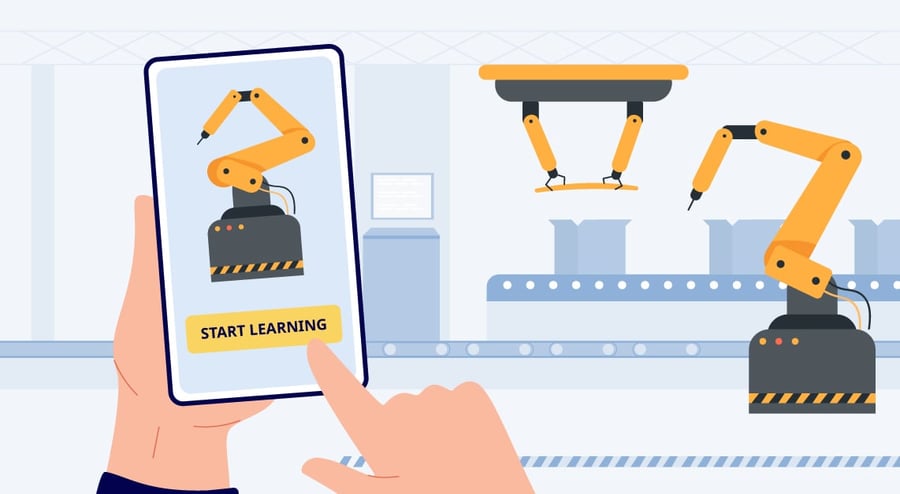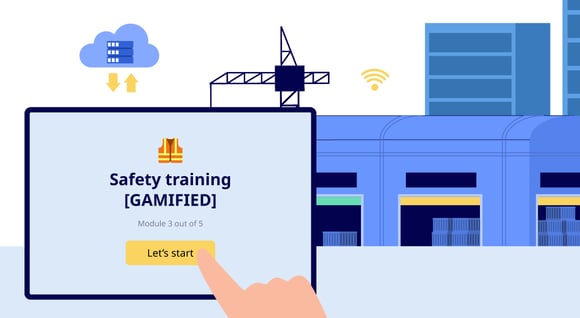Let's be real – production training isn't always the most exciting thing in the world. From sitting through long lectures and struggling to stay awake as you read through the safety manual, it's not exactly the highlight of anyone's training.
Yet, training in the production industry is essential as the industry is evolving at an unprecedented pace, driven by rapid technological advancements and the need for enhanced skills.
To stay ahead in this dynamic landscape, companies must embrace innovative training methods that empower their workforce with the knowledge and capabilities required for success and safety.
What if you could make the oh-so-important production training for your workers engaging, effective, and, dare we say, fun? Now, that would be the future of production training! And honestly, a digital learning platform could help you come closer to all that. Let's dive right in!
Wanna jump to certain sections? That's fine. Click on the part you are most interested in:
📊 What the stats are saying 👷 Lindab, a case as an example
📲 6 Reasons to going digital 💡 Summary
Unleash the Power of Digital Learning in Production Training
It's no secret that upskilling the workforce is crucial for staying competitive in today's manufacturing industry. But traditional production training methods can be limiting – from a lack of flexibility in learning formats to a one-size-fits-all approach that doesn't account for individual learning styles and needs.
And this is where digital learning & learning platforms come in. Because digital learning can help you give a more flexible, personalized, and accessible way to train your workers.
It is faster and easier to create production training courses for the admins. It will also allow you to collect all employee training in one place, connecting on-site training with digital production learning.
No, we are not saying you should skip on-site & face-to-face training completely. It is still very important part in the production training.
What we are saying, however, is that with a digital learning platform, you can optimize the training, and make your in-person training and digital training work its magic– together in a blended learning approch. Making your total production learning and training effective and efficient.
Is Digital Production Training Necessary?
Well, before answering that, let us look at some stats from the World Economics Forum's Future of Jobs Report 2023:
- 25% of jobs in the manufacturing & production sector are expected to change in the next five years due to technological advancements and automation
- By 2025, the share of tasks performed by machines is projected to increase to 50% in the Production industry, leading to a shift in job requirements and skills
- 40% of companies in the manufacturing sector expect to increase their workforce in roles that require advanced technological skills
- 85% of companies in the production industry plan to expand upskilling and reskilling programs to address skill gaps within their workforce
- 78% of manufacturing & production industry executives believe that the increasing automation and digitization will require new training programs for the existing workforce
Digital training might not always be a necessity - in all cases. As always, it depends on your business and your goals. But looking at the stats presented above gives us an idea of the scope of the challenges and the speed we're approaching it in.
Integrating a digital learning platform into your production training regime can work wonders and help you adjust to the changes and future needs faster and smoother.
As a learning and development or human resources professional, a platform will help you deliver high-quality training programs to your employees that enhance productivity, quality, safety, and drive business success. With a learning platform, your work becomes more efficient, paving the way for the future of production training.
Lindab, a leading ventilation company in Europe with over 5000 employees and a lot of employees working directly in manufacturing & production, has learned the benefits of a digital learning platform. Have a look at what they have to say about it in this video 👇
Even if you're a small business, it's worth considering the advantages that can be gained from implementing such a system. Below we'll explore some of the benefits.
Going Digital- 6 Reasons
Yes, we have mentioned some benefits above, but here comes a list of reasons why using a digital learning platform for production training is beneficial. (Feel free to share with whoever needs to hear it 😉). Let's take a look:
- Adaptability to Technological Advancements: The manufacturing industry is undergoing rapid technological advancements, such as automation, robotics, Internet of Things (IoT), and data analytics.
A digital learning platform can easily integrate and deliver training content on these evolving technologies, ensuring that employees stay up-to-date with the latest industry trends. - Accessibility and Flexibility: Going digital allows you to reach your employees with training anytime and on any device. No need to bring them all into one room. It allows your production/manufacturing employees to access training materials at their convenience, whether they have a work environment that is on-site in a factory, in the office or remote.
A digital learning platform provides the flexibility to accommodate different learning styles and preferences, allowing individuals to learn at their own pace and revisit content as needed.
- Enhanced Engagement & Personalized Learning Experience: Digital learning platforms often offer interactive features such as quizzes, simulations, and gamification elements that promote active engagement and participation.
They will also help tailor training to the needs and preferences of individual learners. Some platforms allow you to set up personalized learning flows with triggers that will release specific training based on role, department, or whatever you decide the triggers to be.
These elements make the learning experience more enjoyable, increase knowledge retention, and encourage employees to take ownership of their learning journey.
- Track progress, measure effectiveness & create reports: Another biggest advantage of digital learning platforms is the ability to track progress and measure the effectiveness of training.
This training data provides valuable insights into individual and organizational training effectiveness.
Organizations can identify areas where employees may be struggling, optimize training content, and make data-driven decisions to improve the learning experience continuously.
- Easy Update, Continuous Learning & Knowledge Retention: Got mandatory safety or product training that needs an update? With the right platform, you can quickly update training modules and automatically send the updated versions to all workers that need to take them.
In the production industry, employees need to constantly update their skills and knowledge to adapt to new technologies, processes, and safety regulations.
A digital learning platform supports continuous learning by making it easy to update training materials for admins and hence, provide updated training, refresher courses, and just-in-time information for employees.
This ensures that employees can quickly acquire and apply new & right knowledge, improving their overall competence and performance.
- Global Scalability and Knowledge Sharing: Manufacturing organizations often have a geographically dispersed workforce or collaborate with partners and suppliers worldwide.
A digital learning platform facilitates global collaboration and knowledge sharing by enabling employees to connect, share best practices, and learn from each other's experiences through discussion forums, virtual classrooms, and collaborative projects.
It also allows for scalable training delivery, ensuring that all employees receive consistent and standardized training materials regardless of their geographical location.
- Cost-effectiveness: Finally, digital learning platforms are often more cost-effective and scalable than traditional training methods.
With the ability to deliver training online, organizations can save money on travel, instructor fees, accommodation, and physical training materials expenses and can easily scale their training programs as needed.
This cost-effective approach makes it feasible to provide comprehensive and ongoing training to a large workforce.

In short
Embracing a digital learning platform for production training is like adding a secret weapon to your arsenal. It enables you as an organization and company to break free from the limitations of traditional training methods and provide accessible, scalable, cost-effective, and engaging training experiences that align with the ever-evolving needs of the manufacturing industry.
Ultimately, this leads to a workforce that's more skilled, adaptable, productive, and ready to take on the future.
Thinking digital learning is the way to go for you and your organization? Don't know where to start?
Have a look at this article which also provides a free template on how to create a business case for digital learning.

